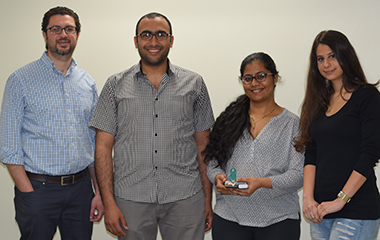Developing Intelligent Transportation
 |
|
From left, Assistant Professor of Electrical Engineering Hany Elgala and his research team, doctoral students Ahmed Hussein, Priti Pachpande, and Monette Khadr. (Photo by Daphne Jorgensen)
|
ALBANY, N.Y. (May 17, 2018) — There are unquestionably a number of benefits to public transportation, from reducing traffic congestion and greenhouse gases to saving money or promoting a healthier lifestyle.
But for those who depend on these systems to get them to and from work, it can be a nerve-racking experience to be waiting for a bus or train that isn’t running on time.
That’s where College of Engineering and Applied Sciences Assistant Professor Hany Elgala’s research comes in.
Working with partners at the university's Parking and Mass Transit Services, the Center for Technology in Government and Office of Facilities Management, Elgala is leading a project to create ‘intelligent’ systems that use very little energy but provide a vast amount of data that can be used to improve transportation systems.
The team of researchers is investigating the feasibility of applying ultra-wideband (UWB) technology to public transportation systems.
"UWB is a wireless radio system that uses a small amount of energy for simultaneous ranging, location tracking, and transmission of large amounts of data over a wide range of frequency bandwidths," explained G. Brian Burke, managing director of CTG at UAlbany in the report.
For public transportation, UWB could provide numerous benefits, including better tracking of trains and buses, and potentially eliminating the need for turnstiles, tickets or cards to deposit money or swipe for payment.
The project has caught the attention of a number of media outlets, including The New York Times and Metro Magazine.
"Based on the obtained results, more investigations are needed to study how the technology performs in real world scenarios and associated conditions," Elgala said. "We believe that the UWB technology has much more to offer for metropolitan public transportation including train-to-wayside communication and obstacle detection in front of trains."
This technology, if successfully implemented, could be a boon for the millions of Americans who rely on buses, trains and subways. In 2017 alone, the American Public Transportation Association reported 10.1 billion trips were taken on public transportation.
Elgala is an assistant professor in the Department of Electrical and Computer Engineering at UAlbany, where he leads the Signals & Networks Lab.
Also on the research team were several UAlbany students: Smit Shilu, a graduate student in Computer Science; Priti Pachpande, a doctoral student in the Department of Computer Science; and Ahmed Hussein and Monette Khadr, doctoral students in the Department of Electrical and Computer Engineering.
"During the eight months of research, we as a team faced many challenges, but we articulated a way out with teamwork, knowledge sharing and Professor Elgala's encouragement and motivation," said Pachpande. "I am proud of the fact that our research can be used to help solve real-world problems."
![]() For more news, subscribe to UAlbany's RSS headline feeds
For more news, subscribe to UAlbany's RSS headline feeds
A comprehensive public research university, the University at Albany-SUNY offers more than 120 undergraduate majors and minors and 125 master's, doctoral and graduate certificate programs. UAlbany is a leader among all New York State colleges and universities in such diverse fields as atmospheric and environmental sciences, business, education, public health,health sciences, criminal justice, emergency preparedness, engineering and applied sciences, informatics, public administration, social welfare and sociology, taught by an extensive roster of faculty experts. It also offers expanded academic and research opportunities for students through an affiliation with Albany Law School. With a curriculum enhanced by 600 study-abroad opportunities, UAlbany launches great careers.


